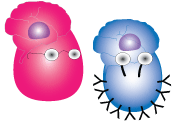
Linear and conformational epitopes
B cells arrive in the lymph node and become activated in the T cell zone. Here they capture antigens that either have been free-flowing in the lymph or transported to lymph nodes by antigen presenting cells. To become activated, naïve B cells first need intact antigen to cross-link their surface Ig and this kicks off a myriad of events that results in B cell activation.
Before we continue exploring what happens during B cell activation, let's take a moment to think about this initial antigen:Ig interaction that starts the activation process in the first place. As we know from previous pages, only a portion of an antigen touches the antigen specific part of the Ig. This portion of the antigen is called an epitope. An epitope can either be a continuous piece of antigen or can be made from separated bits that are brought together by protein folding. These two different kinds of epitopes are referred to as linear and conformational epitopes respectively, and to illustrate these we are now going to use our imagination!
All proteins are made up of a long string of amino acids that are folded backwards and forwards, inwards and over to give us the finished protein. Imagine this like a piece of wool that we scrunch up into a small ball. If you now take a fat marker pen, to represent the Ig, and place it somewhere on the wool ball you might find that you have marked several places along the string or you might find that only one place got marked when you stretch the string out again. The former scenario where several places of the string (protein) touched the marker pen (antigen specific part of the Ig) represents the conformational epitope, whereas the latter scenario represents the linear epitope. The shape of a protein can, in other words, be an epitope, but these epitopes can also be destroyed if the protein becomes denatured as a result of exposure to, for example, acidity or heat. This denatured protein will therefore no longer be recognized by a B cell that has an Ig specific for a conformational epitope within this antigen. This can, for example, happen when food is cooked, and is the reason for why some allergic people are able to eat certain cooked but not raw foods. Now let's go back and find out what happens next after the Ig has bound the antigen.